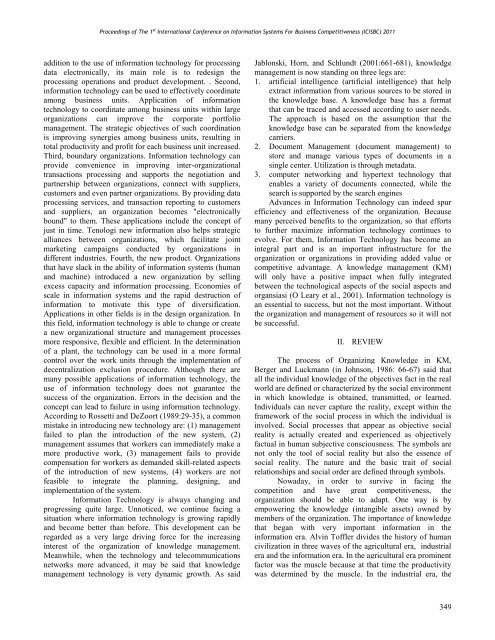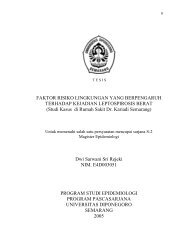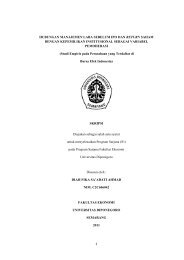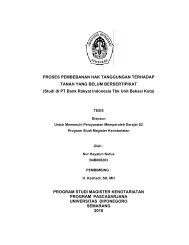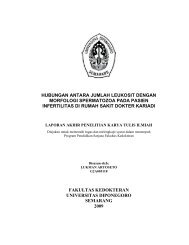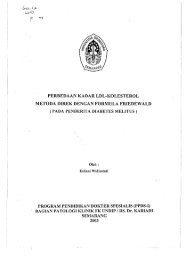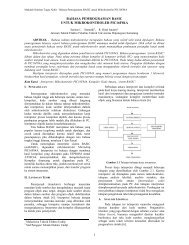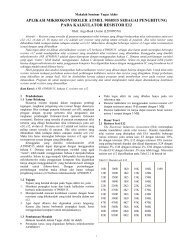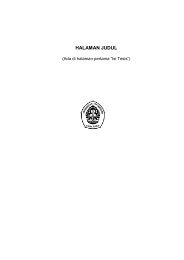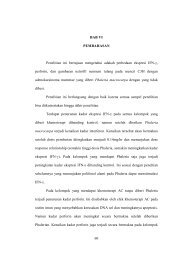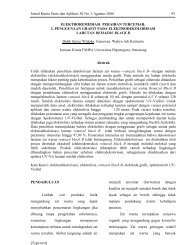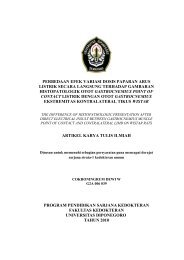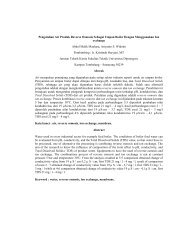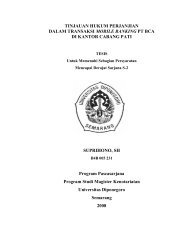Organizing Knowledge in Implementation of Knowledge ...
Organizing Knowledge in Implementation of Knowledge ...
Organizing Knowledge in Implementation of Knowledge ...
You also want an ePaper? Increase the reach of your titles
YUMPU automatically turns print PDFs into web optimized ePapers that Google loves.
Proceed<strong>in</strong>gs <strong>of</strong> The 1 st International Conference on Information Systems For Bus<strong>in</strong>ess Competitiveness (ICISBC) 2011<br />
addition to the use <strong>of</strong> <strong>in</strong>formation technology for process<strong>in</strong>g<br />
data electronically, its ma<strong>in</strong> role is to redesign the<br />
process<strong>in</strong>g operations and product development. . Second,<br />
<strong>in</strong>formation technology can be used to effectively coord<strong>in</strong>ate<br />
among bus<strong>in</strong>ess units. Application <strong>of</strong> <strong>in</strong>formation<br />
technology to coord<strong>in</strong>ate among bus<strong>in</strong>ess units with<strong>in</strong> large<br />
organizations can improve the corporate portfolio<br />
management. The strategic objectives <strong>of</strong> such coord<strong>in</strong>ation<br />
is improv<strong>in</strong>g synergies among bus<strong>in</strong>ess units, result<strong>in</strong>g <strong>in</strong><br />
total productivity and pr<strong>of</strong>it for each bus<strong>in</strong>ess unit <strong>in</strong>creased.<br />
Third, boundary organizations. Information technology can<br />
provide convenience <strong>in</strong> improv<strong>in</strong>g <strong>in</strong>ter-organizational<br />
transactions process<strong>in</strong>g and supports the negotiation and<br />
partnership between organizations, connect with suppliers,<br />
customers and even partner organizations. By provid<strong>in</strong>g data<br />
process<strong>in</strong>g services, and transaction report<strong>in</strong>g to customers<br />
and suppliers, an organization becomes "electronically<br />
bound" to them. These applications <strong>in</strong>clude the concept <strong>of</strong><br />
just <strong>in</strong> time. Tenologi new <strong>in</strong>formation also helps strategic<br />
alliances between organizations, which facilitate jo<strong>in</strong>t<br />
market<strong>in</strong>g campaigns conducted by organizations <strong>in</strong><br />
different <strong>in</strong>dustries. Fourth, the new product. Organizations<br />
that have slack <strong>in</strong> the ability <strong>of</strong> <strong>in</strong>formation systems (human<br />
and mach<strong>in</strong>e) <strong>in</strong>troduced a new organization by sell<strong>in</strong>g<br />
excess capacity and <strong>in</strong>formation process<strong>in</strong>g. Economies <strong>of</strong><br />
scale <strong>in</strong> <strong>in</strong>formation systems and the rapid destruction <strong>of</strong><br />
<strong>in</strong>formation to motivate this type <strong>of</strong> diversification.<br />
Applications <strong>in</strong> other fields is <strong>in</strong> the design organization. In<br />
this field, <strong>in</strong>formation technology is able to change or create<br />
a new organizational structure and management processes<br />
more responsive, flexible and efficient. In the determ<strong>in</strong>ation<br />
<strong>of</strong> a plant, the technology can be used <strong>in</strong> a more formal<br />
control over the work units through the implementation <strong>of</strong><br />
decentralization exclusion procedure. Although there are<br />
many possible applications <strong>of</strong> <strong>in</strong>formation technology, the<br />
use <strong>of</strong> <strong>in</strong>formation technology does not guarantee the<br />
success <strong>of</strong> the organization. Errors <strong>in</strong> the decision and the<br />
concept can lead to failure <strong>in</strong> us<strong>in</strong>g <strong>in</strong>formation technology.<br />
Accord<strong>in</strong>g to Rossetti and DeZoort (1989:29-35), a common<br />
mistake <strong>in</strong> <strong>in</strong>troduc<strong>in</strong>g new technology are: (1) management<br />
failed to plan the <strong>in</strong>troduction <strong>of</strong> the new system, (2)<br />
management assumes that workers can immediately make a<br />
more productive work, (3) management fails to provide<br />
compensation for workers as demanded skill-related aspects<br />
<strong>of</strong> the <strong>in</strong>troduction <strong>of</strong> new systems, (4) workers are not<br />
feasible to <strong>in</strong>tegrate the plann<strong>in</strong>g, design<strong>in</strong>g, and<br />
implementation <strong>of</strong> the system.<br />
Information Technology is always chang<strong>in</strong>g and<br />
progress<strong>in</strong>g quite large. Unnoticed, we cont<strong>in</strong>ue fac<strong>in</strong>g a<br />
situation where <strong>in</strong>formation technology is grow<strong>in</strong>g rapidly<br />
and become better than before. This development can be<br />
regarded as a very large driv<strong>in</strong>g force for the <strong>in</strong>creas<strong>in</strong>g<br />
<strong>in</strong>terest <strong>of</strong> the organization <strong>of</strong> knowledge management.<br />
Meanwhile, when the technology and telecommunications<br />
networks more advanced, it may be said that knowledge<br />
management technology is very dynamic growth. As said<br />
Jablonski, Horn, and Schlundt (2001:661-681), knowledge<br />
management is now stand<strong>in</strong>g on three legs are:<br />
1. artificial <strong>in</strong>telligence (artificial <strong>in</strong>telligence) that help<br />
extract <strong>in</strong>formation from various sources to be stored <strong>in</strong><br />
the knowledge base. A knowledge base has a format<br />
that can be traced and accessed accord<strong>in</strong>g to user needs.<br />
The approach is based on the assumption that the<br />
knowledge base can be separated from the knowledge<br />
carriers.<br />
2. Document Management (document management) to<br />
store and manage various types <strong>of</strong> documents <strong>in</strong> a<br />
s<strong>in</strong>gle center. Utilization is through metadata.<br />
3. computer network<strong>in</strong>g and hypertext technology that<br />
enables a variety <strong>of</strong> documents connected, while the<br />
search is supported by the search eng<strong>in</strong>es<br />
Advances <strong>in</strong> Information Technology can <strong>in</strong>deed spur<br />
efficiency and effectiveness <strong>of</strong> the organization. Because<br />
many perceived benefits to the organization, so that efforts<br />
to further maximize <strong>in</strong>formation technology cont<strong>in</strong>ues to<br />
evolve. For them, Information Technology has become an<br />
<strong>in</strong>tegral part and is an important <strong>in</strong>frastructure for the<br />
organization or organizations <strong>in</strong> provid<strong>in</strong>g added value or<br />
competitive advantage. A knowledge management (KM)<br />
will only have a positive impact when fully <strong>in</strong>tegrated<br />
between the technological aspects <strong>of</strong> the social aspects and<br />
organsiasi (O Leary et al., 2001). Information technology is<br />
an essential to success, but not the most important. Without<br />
the organization and management <strong>of</strong> resources so it will not<br />
be successful.<br />
II. REVIEW<br />
The process <strong>of</strong> <strong>Organiz<strong>in</strong>g</strong> <strong>Knowledge</strong> <strong>in</strong> KM,<br />
Berger and Luckmann (<strong>in</strong> Johnson, 1986: 66-67) said that<br />
all the <strong>in</strong>dividual knowledge <strong>of</strong> the objectives fact <strong>in</strong> the real<br />
world are def<strong>in</strong>ed or characterized by the social environment<br />
<strong>in</strong> which knowledge is obta<strong>in</strong>ed, transmitted, or learned.<br />
Individuals can never capture the reality, except with<strong>in</strong> the<br />
framework <strong>of</strong> the social process <strong>in</strong> which the <strong>in</strong>dividual is<br />
<strong>in</strong>volved. Social processes that appear as objective social<br />
reality is actually created and experienced as objectively<br />
factual <strong>in</strong> human subjective consciousness. The symbols are<br />
not only the tool <strong>of</strong> social reality but also the essence <strong>of</strong><br />
social reality. The nature and the basic trait <strong>of</strong> social<br />
relationships and social order are def<strong>in</strong>ed through symbols.<br />
Nowaday, <strong>in</strong> order to survive <strong>in</strong> fac<strong>in</strong>g the<br />
competition and have great competitiveness, the<br />
organization should be able to adapt. One way is by<br />
empower<strong>in</strong>g the knowledge (<strong>in</strong>tangible assets) owned by<br />
members <strong>of</strong> the organization. The importance <strong>of</strong> knowledge<br />
that began with very important <strong>in</strong>formation <strong>in</strong> the<br />
<strong>in</strong>formation era. Alv<strong>in</strong> T<strong>of</strong>fler divides the history <strong>of</strong> human<br />
civilization <strong>in</strong> three waves <strong>of</strong> the agricultural era, <strong>in</strong>dustrial<br />
era and the <strong>in</strong>formation era. In the agricultural era prom<strong>in</strong>ent<br />
factor was the muscle because at that time the productivity<br />
was determ<strong>in</strong>ed by the muscle. In the <strong>in</strong>dustrial era, the<br />
349


